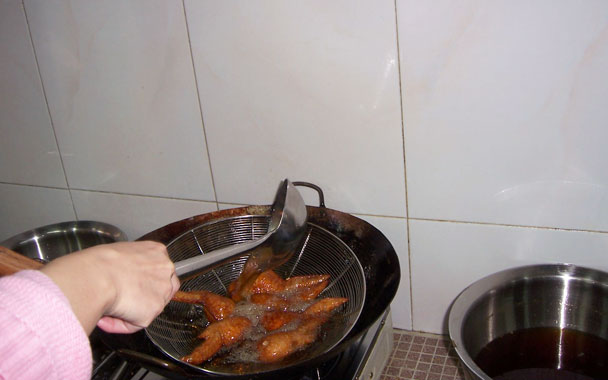It’s a policy of mine not to do things I regret, but I should have thought twice before writing this in the May issue of the magazine: “You can fry—beautifully, greaselessly—by dumping cold oil on hot food.”
The story was about a Chinese cooking school in Hong Kong, where the instructor, Martha Sherpa, is absolutely serious (“I’m not a clown,” she said to me. “I don’t make jokes.”) and an absolutely wonderful teacher.
What I learned in my four days with her was mind blowing: techniques and even ways of thinking about cooking that were so different from what I’d been taught in French-based kitchens that I thought they were opposites. So maybe I got a little overexcited while writing that sentence; on second reading, I realize how it can cause some confusion. I didn’t mean that you can fry by literally just putting cold oil on a hot piece of food. Maybe Grant Achatz or Wylie Dufresne is working on that, but as far as I know, it’s not something you can do.
What I did mean, though, is that the frying method Martha taught me seemed to run counter to every lesson on frying that I’ve ever been taught in a Western kitchen. In restaurants, in culinary school, I was always told that you HAVE to keep the oil hot enough so that food sizzles the moment it’s dropped into the fryer: The sizzling is the sound of water vaporizing out of the food, pushing its way out like people getting off a crowded subway car. This action prevents oil from flooding into the food, making it greasy. So I was shocked when, after we’d dropped spring rolls into a wok of hot oil, Martha had me dump in a bucket of the cold stuff.
The technique isn’t actually that weird, once I thought about it. It’s basically a way to control the temperature while frying. You begin in hot oil to start the cooking process and the vaporizing. Then you dump in cold oil until it’s barely sizzling. The idea is that it still cooks the food without overbrowning or sealing the outside yet, almost like an oil-poach. Don’t worry that cold oil will soak into the food, because once it’s nearly cooked through, you jack the fire back up and the evaporating moisture forces out whatever oil did make its way in. The end result is food that’s cooked through evenly, as ungreasy as fried food can be; and the long cooking time allows you to evaporate all the moisture from the shell, so it’s super crispy and stays crisp for hours. Martha deliberately showcased this technique with spring rolls, which have a moist filling and a crunchy shell.
And then I think about French fries, and how the best ones are usually made by cooking them twice—first you throw them in cooler oil to ensure tender potatoes, then you take them out and turn up the heat, waiting for the oil to get hot enough for a second dunk to crisp and color them.
But in a wok, this process is seamless. The beauty of using a wok for frying is that it conducts heat well but doesn’t retain it. Coupled with a high-firepower burner underneath, a wok gives you very sensitive heat control; you can get the oil hot and cold quickly without having to take the food out in between. Learning the technique is a matter of learning how fluidly the temperature can change, an elastic and graceful process.




 Pinterest
Pinterest


